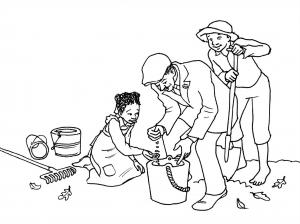Junior Composter Course
The Junior Composter course is an internship for youth from underserved communities to engage in composting, urban agriculture, and environmental activism.
Leader
Stephanos Koullias
Location
Astoria Astoria, NY 11102
Impact areas
About the project
NYC's wastestream is comprised of 17% food scraps. There are several issues associated with food waste, including: -Methane (a Greenhouse Gas 27x more potent than CO2) which is generated when food scraps are deposited in a landfill. -Ground water pollution. When food waste is deposited in landfills, the accumulation becomes an environmental hazard. The hazard accumulated with this accumulation includes the runoff from the food waste into underground water deposits. -Land Use. A lot of land is put out of use from more productive purposes when it becomes a landfill. The communities around those landfills suffer environmentally and economically, as a result. -Oil. Transporting food and food waste has been linked to one of the greatest human contributions to global warming. These changes come as a result of cumulative activity, and the practices behind these activities have been learned, and can be unlearned. -Soil. In the city, much of the soil is contaminated due to human activity. Some of this contamination can be reversed through the application of compost. In addition, soil is being depleted due to poor management practices at an alarming rate, at the same time food prices are increasing and the nutritional value of available food is becoming an ever greater concern. Compost increases the vitality of the soil, thereby promoting plant health, which results in healthier vegetables.
The Steps
The Junior Composter Course will run for eight weeks over the summer, in indoor and outdoor classrooms. The youth will be provided with a work schedule --accepting and making compost-- a reading curriculum, and a hands-on project. The participants will recieve a stipend of both money and other currency to use at Greenmarkets in western Queens where composting is taking place, as well as a bicycle from Recycle-a-Bicycle to get to and from the markets. Working with various gardening and greening groups in northwestern Queens (ARROW Community Garden, Build It Green!NYC, City Growers, LIC Community Garden, Sunnyside Gardens Park Community Garden, Two Coves Community Garden, Western Queens Compost Initiative), the youth will meet at a market once a week to discuss the readings with a program coordinator. Each of the youth will also assist with compost drop-off's at Greenmarkets in western Queens, and creating compost at one of four community gardens, and an urban farm.
Why we‘re doing it
The Junior Composter Course is a summer internship for youth aged 16-18 from underserved and immigrant communities. Many of these communities are already familiar with the practices of composting, but the knowledge and skills aren't passed on to younger generations, as composting is seen as backward and obsolete in more modern setting. Youth represent hope for the future. Moreover, underserved and imigrant communities are often the most affected by environmental injustices, with the fewest resources to address those issues. The youth who are enrolled in the Junior Composter course will be given the tools to contribute to a cleaner, healthier environment and empower their family and community to contribute to a greener NYC. In addition ato addressing environmental concerns, one of the greater challenges that youth face is dispair associated with being powerless to make a menaingful contribution to improving the environment. The youth, as a result of working in the Greenmarkets, gardens and farms, and discussing compost with patrons and volunteers, will be exposed to careers in the green collar and urban agriculture sectors.

